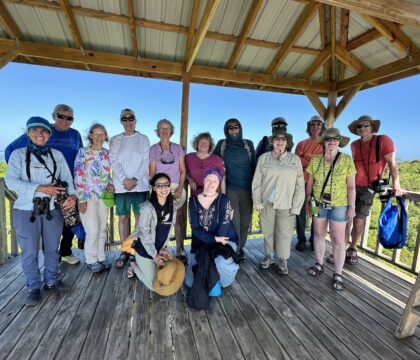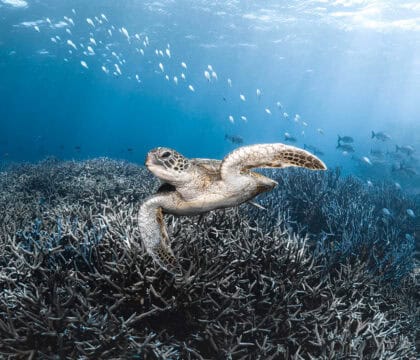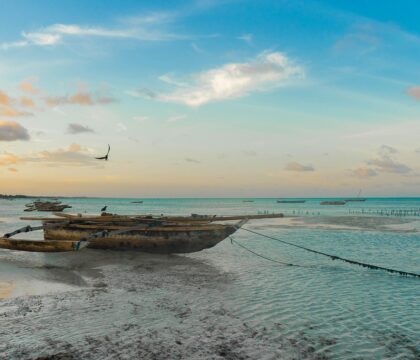September 4, 2025 • Ocean Facts, Travel Ideas
Few places on Earth hold such legendary status among wildlife lovers as the Galápagos Islands.
This remote volcanic archipelago, located in the Pacific Ocean approximately 600 miles off the coast of Ecuador, gained fame nearly two hundred years ago when Charles Darwin theorized about evolution while studying its unique flora and fauna. More than 80% of the Galapagos Islands’ land birds, 97% of reptiles and land mammals, and 30% of plants are found nowhere else on Earth. All told, more than 9,000 species inhabit the 20 islands of the Galápagos, where ecosystems range from subtropical to arid highlands, resulting in a variety of species that have evolved in isolation from the rest of the world.
In this article, we explore some of the most iconic Galapagos animal species—read on!

The iconic Galapagos tortoise is a highlight of every trip. © Roderic Mast
Galápagos Tortoises (Chelonoidis spp.)
These giant reptiles are the most iconic residents of the Galápagos Islands, capable of living over 100 years and weighing hundreds of pounds. The 12 extant species are “ecosystem engineers,” dispersing seeds, trampling paths, and shaping vegetation across the islands.
190 years ago, Charles Darwin’s curiosity was piqued by these tortoises when he learned that each type of tortoise was different depending on their island habitat. For example, the saddleback-shaped shells of the tortoises on Española (Hood) Island allow their necks to extend farther upward to reach vegetation high off the ground, thus enabling them to feed on the tall plants found on that island, whereas tortoise species from other islands have domed shells that are suited for grazing on grasses and other low vegetation.
Once heavily hunted by explorers and further threatened by invasive species such as rats (which prey on eggs), Galápagos tortoise numbers declined drastically in the 20th century. Conservation programs, including breeding centers, have since helped stabilize some populations. Still, several subspecies are critically endangered, two have gone extinct, and one was famously rediscovered in 2019 after being thought extinct for over 112 years.
Quick Facts:
- Average Lifespan: 80–170 years (oldest recorded: 175 years old)
- Average Size: 4–6 ft long; and weigh 250–900 lbs (largest recorded: 919 lbs)
- Habitat & Range: Dry low-lying areas and lush highlands throughout Santa Cruz, San Cristobal, Isabela, Española, Pinzón, and Santiago islands
- Diet: Herbivorous — primarily grasses, leaves, cacti, fruits, flowers, and vines
- Conservation Status: Vulnerable. An estimated 15,000 remain across all subspecies in the wild.
- Where to See Them: Highlands of Santa Cruz Island, and at the Fausto Llerena Tortoise Center
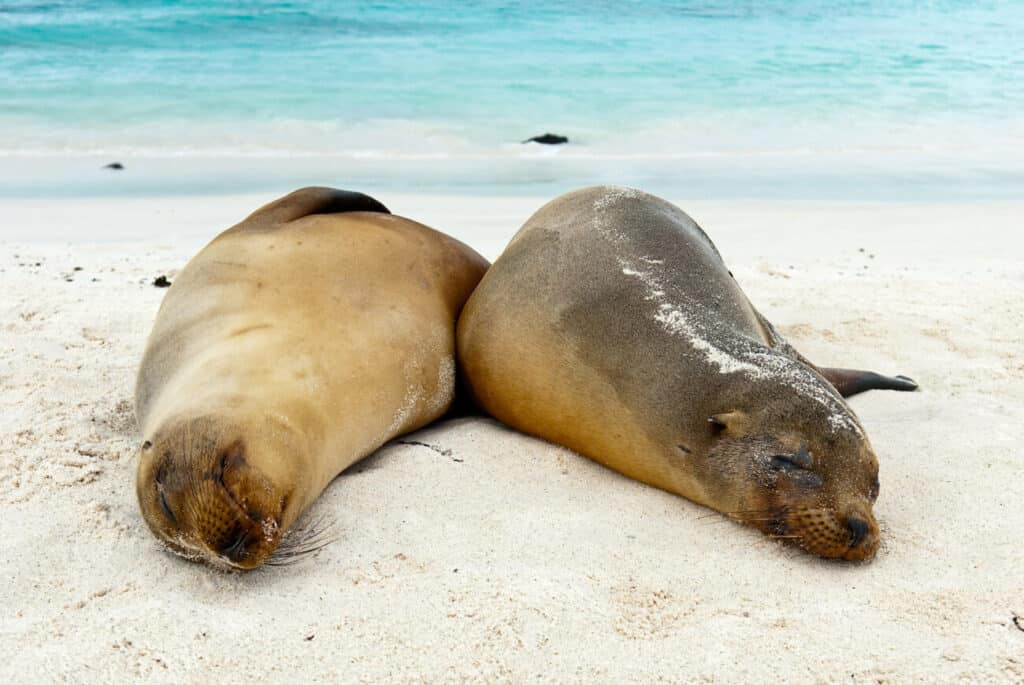
Galapagos sea lions are unafraid of people, offering the chance to see them up close. © Roderic Mast
Galápagos Sea Lion (Zalophus wollebaeki)
The Galápagos sea lion is one of the most iconic and charismatic residents of the islands. They are commonly found lounging on sandy beaches, rocky shorelines, and even the docks of island towns, often in surprisingly close proximity to people. Large colonies thrive on Española, San Cristóbal, and Santa Fe islands, making them some of the best places to witness their fascinating social behavior.
Breeding season occurs from June to December, when dominant males (called bulls) defend beach territories and harems of females. From March to May, newborn pups can be seen along the coasts, often playfully bounding across the sand or splashing in the shallows.
For many ecotourists, snorkeling with Galápagos sea lions is a highlight of their visit to the archipelago. Known for their playful and curious nature, these animals often swim near divers and snorkelers, seemingly eager to interact. However, respectful observation is essential. Visitors should maintain distance, especially from pups and nursing females, and never attempt to touch or feed sea lions.
Ecologically, Galápagos sea lions are important nearshore predators, helping regulate populations of schooling fish and supporting the balance of marine ecosystems.
Quick Facts:
- Average Lifespan: 15–20 years
- Average Size: 4–8 feet long, weighing 110–860 lbs.
- Habitat & Range: Sandy beaches, rocky shorelines, and coastal waters throughout the Galápagos
- Diet: Carnivorous — primarily feeds on sardines, mackerel, squid, and other small schooling fish
- Conservation Status: Endangered. An estimated 20,000 individuals live across the archipelago and are threatened by boat traffic, fishing entanglement, plastic marine waste, and loss of prey due to climate change.
- Where to See Them: Large colonies can be found on Española, San Cristóbal, and Santa Fe islands. Breeding season (June–December) offers dramatic male displays, while March–May is the best time to see newborn pups.
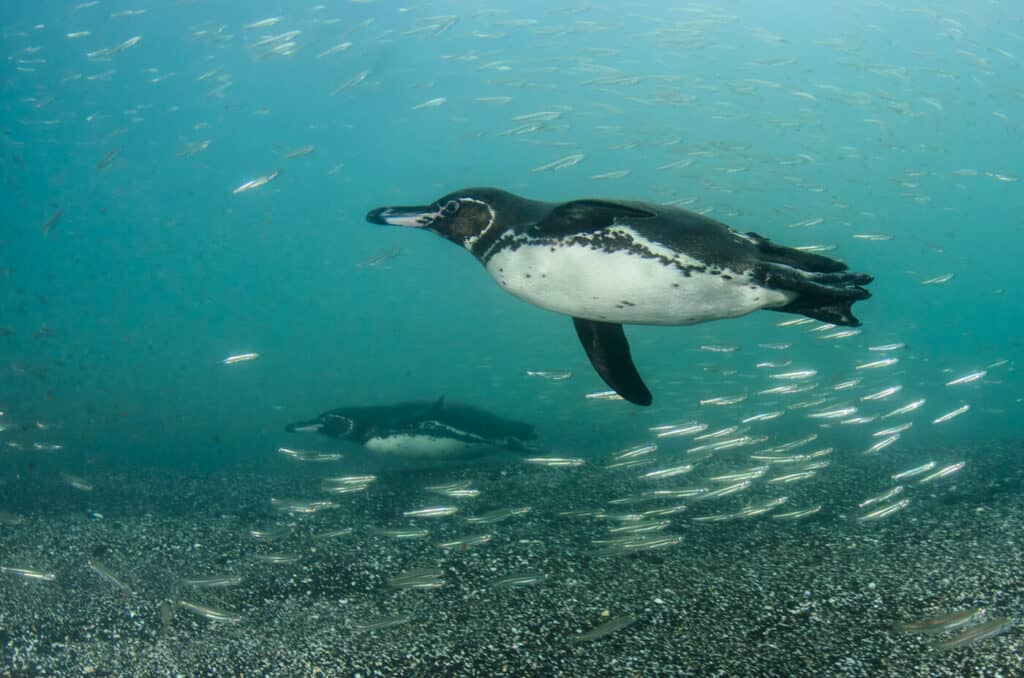
Galápagos penguins swim gracefully in the protected waters of the Galápagos Marine Reserve © Pete Oxford
Galápagos Penguin (Spheniscus mendiculus)
The Galápagos penguin is the only penguin species found north of the equator. Unlike most penguins that live in polar regions, where cold waters provide abundant fish and the cool temperatures needed for nesting, the Galápagos penguin survives near the equator thanks to the Humboldt and Cromwell ocean currents, which carry cold, nutrient-rich waters. This rare environment makes the Galápagos one of the only places in the world where penguins live alongside reptiles like the marine iguana.
Only about 2,000 Galápagos penguins remain in the wild. Due to their dependence on cool waters, these animals are highly vulnerable to the effects of climate change, particularly during El Niño events when global ocean temperatures rise, reducing their breeding success and limiting food sources.
Quick Facts:
- Average Lifespan: 15–20 years
- Average Size: 10-20 inches tall, weighing 5-10 lbs
- Habitat & Range: Rocky coastlines of Isabela and Fernandina Islands; smaller populations found on Bartolomé, Santiago, and Floreana Islands.
- Diet: Carnivorous — primarily feed on krill, small crustaceans, marine invertebrates, and schooling fish.
- Conservation Status: Endangered
- Where to See Them: Isabela and Fernandina islands, where the largest colonies nest in volcanic crevices along the shore.
Galápagos Iguanas

Marine iguanas can be black, green, or red, depending on which island they live on. © Roderic Mast
Galápagos Marine Iguana (Amblyrhynchus cristatus)
The Galápagos marine iguana is the only sea-going lizard in the world, uniquely adapted to forage on algae growing over submerged volcanic rocks. These reptiles can grow to over three feet long and dive to depths of up to 30 feet, using their fin-like tails to swim powerfully through the water.
After feeding, they can be seen basking on lava rocks to warm up (a behavior known as thermoregulation) and are often seen sneezing out excess salt using a special nasal gland.
Marine iguanas are commonly seen across the archipelago, particularly on Fernandina and Española Islands, where they nest along the sandy beaches and occasionally in volcanic ash. During mating season (January to March), males become more colorful, adding red and green hues to their otherwise black scales, and compete with other males for mates. The most brightly colored males are found on Española Island during mating season. Although an estimated 200,000 to 300,000 individuals remain in the wild, the species is considered Vulnerable. Of the 11 recognized subspecies, several are listed as Endangered or Critically Endangered. Marine iguanas are threatened by warming waters that reduce algae abundance, invasive species (such as cats, dogs, and rats that prey on eggs and juveniles), and human activities that disrupt breeding and basking behavior.
Quick Facts:
- Average Lifespan: 5–12 years (oldest recorded: 75 years old).
- Average Size: 2–5 feet long, weighing 1–3 lbs.
- Habitat & Range: Along the volcanic rocky shores, beaches, and mangrove coastlines throughout the Galápagos.
- Diet: Herbivorous — mainly algae that grows over submerged volcanic rocks.
- Conservation Status: Vulnerable. 200,000–300,000 individuals remain, but several subspecies are Endangered or Critically Endangered.
- Where to See Them: Common across the islands, especially on Fernandina and Española.
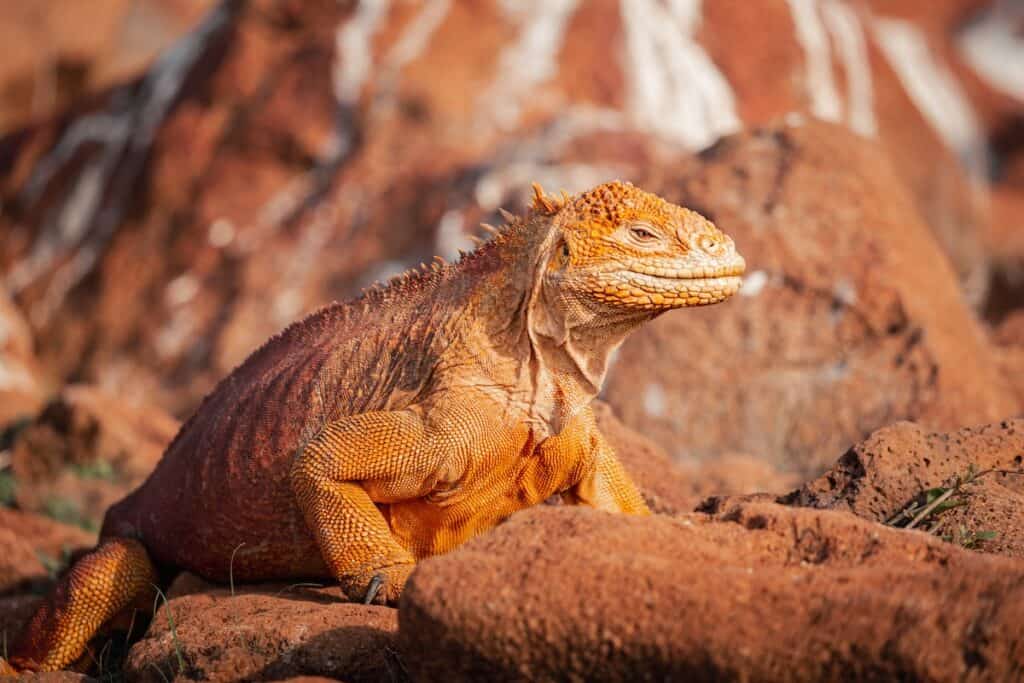
A Galápagos land iguana basks in the sun, blending into the volcanic landscape of the islands. © Robb Leahy
Galápagos Land Iguanas (Conolophus spp.)
While there is only one species of marine iguana, there are three species of Galápagos land iguanas: the common land iguana (Conolophus subcristatus), the Santa Fe land iguana (Conolophus pallidus), found only on Santa Fe Island, and the rare pink land iguana (Conolophus marthae), found only on Wolf Volcano, Isabela Island.
Land iguanas are larger than their marine cousins, growing up to five feet long, and have golden-hued scales. They forage on cactus pads, fruits, and flowers in arid environments, dispersing seeds and helping vegetation spread. Their burrows are often reused by other animals, and visitors may even spot finches perched on their backs, picking ticks from between their scales.
Unlike the relatively abundant marine iguana, land iguanas are fewer in number, with only 5,000 to 10,000 individuals remaining across all three species. Populations plummeted in the early 20th century due to invasive species, but thanks to successful conservation efforts, their numbers are slowly rebounding.
Quick Facts:
- Average Lifespan: 50–60 years.
- Average Size: 3–5 feet long, weighing 28–30 lbs.
- Habitat & Range: Dry lowland areas of Santa Cruz, North Seymour, Baltra, Isabela, and South Plaza islands.
- Diet: Herbivorous – primarily cactus pads, fruits, flowers, seeds, shrubs, and small trees; occasionally insects or carrion.
- Conservation Status: Vulnerable.
- Where to See Them: Cerro Dragón on Santa Cruz Island, or breeding stations on San Cristóbal, Santa Cruz, and Isabela islands.
Birdlife of the Galápagos
The Galápagos Islands are a birdwatcher’s paradise, home to many species found nowhere else on Earth. From striking seabirds like the Blue-footed Booby to the iconic Darwin’s finches that inspired groundbreaking scientific discoveries, the archipelago’s avian life is as diverse as it is unique. Visitors can expect to see birds thriving in all of the archipelago’s many ecosystems.
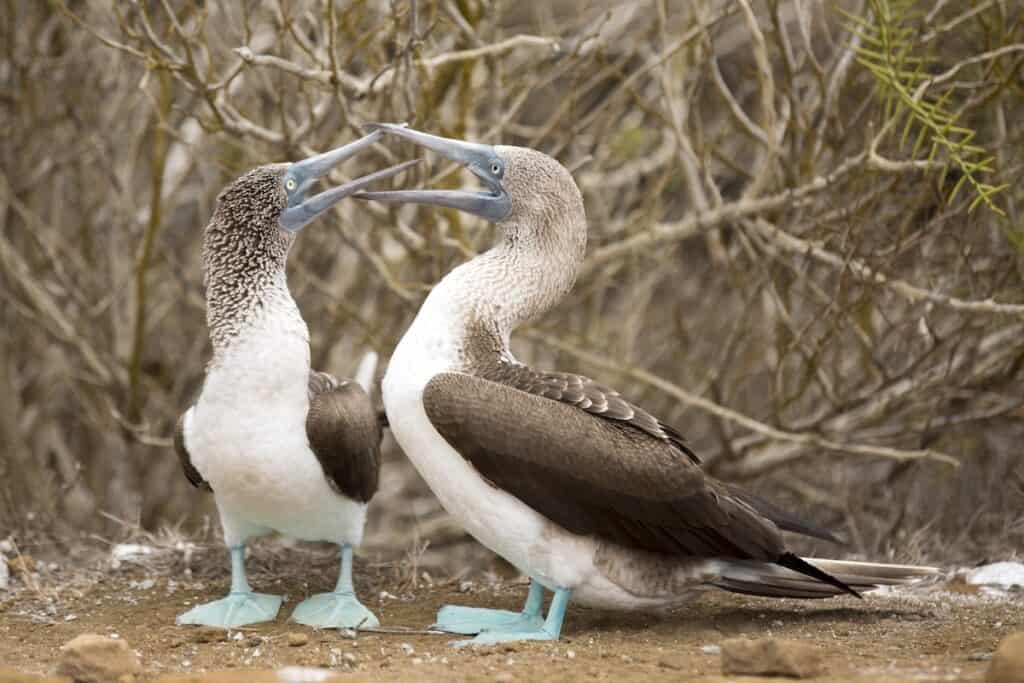
Blue-footed Boobies are one of the most iconic seabirds of the Galápagos, famous for their bright blue feet and elaborate mating dance. © Yolanda Escobar
Blue-footed Booby (Sula nebouxii)
The Blue-footed Booby is one of three booby species found in the Galápagos, and one of the most recognizable seabirds in the islands, known for its vivid turquoise feet that it displays during their elaborate mating dance (often seen between June and August).
While Blue-footed Boobies are clumsy on land, they are swift in the air and agile swimmers, capable of diving up to 60 feet in search of small pelagic fish like sardines, their preferred prey.
Approximately 6,400 individuals live on Galápagos (half of the global population), making the archipelago a critical environment for the species.
Quick Facts:
- Average Lifespan: 15–20 years.
- Average Size: 32–34 inches long, weighing 3.5 lbs; 5-foot wingspan.
- Habitat & Range: Coastal cliffs, rocky shorelines, and flat nesting areas on Española, North Seymour, and Isabela.
- Diet: Small schooling fish such as sardines, anchovies, and mackerel.
- Conservation Status: Least Concern. The population is considered stable.
- Where to See Them: Española Island (Punta Suárez), North Seymour, and occasionally Santa Cruz
Red-footed Booby (Sula sula)
The Red-footed Booby is the smallest and most widespread of the Galápagos boobies, easily recognized by its bright red feet and contrasting plumage, which can be white, brown, or a mix of both. Agile fliers and swimmers, they hunt for small fish and squid, often diving gracefully from great heights to catch prey. The Galápagos hosts significant breeding colonies, making it an important habitat for the species.
Quick Facts:
- Average Lifespan: 22 years
- Average Size: 24–28 inches long, weighing 2–3 lbs; 3-foot wingspan.
- Habitat & Range: Coastal trees and shrubs on islands such as Genovesa, Española, and North Seymour.
- Diet: Small fish and squid, caught by plunge-diving.
- Conservation Status: Least Concern. Populations are generally stable, though threatened locally by invasive species.
- Where to See Them: Although abundant in the Galápagos, Red-footed Boobies are less widespread than their booby cousins. They primarily nest on Genovesa and San Cristóbal, but can occasionally be spotted on other islands throughout the archipelago.

Face-to-face encounter: Nazca Masked Boobies up close, highlighting their striking beaks and facial patterns. © Yolanda Escobar
Nazca Booby (Sula granti)
The Nazca Booby, formerly thought to be a subspecies of the Masked Booby (Sula dactylatra), is a large seabird with striking white plumage, black wingtips, and a distinctive black “mask” around the eyes. Males have yellow to orange beaks, while females display a paler, pinkish hue. Known for their dramatic plunge-diving, they hunt fish and squid in open waters, often returning to flat, rocky nesting sites to raise their young.
Quick Facts:
- Average Lifespan: 23 years
- Average Size: 30–35 inches long, weighing 3–5 lbs; 5–6 foot wingspan
- Habitat & Range: Flat coastal nesting areas on islands such as Española, North Seymour, and Genovesa
- Diet: Fish and squid, caught by high-speed plunge-diving
- Conservation Status: Least Concern. Populations are stable, though sensitive to human disturbance at nesting sites.
- Where to See Them: They are often observed at Punta Suárez on Española, Punta Pit on San Cristóbal, and Genovesa.
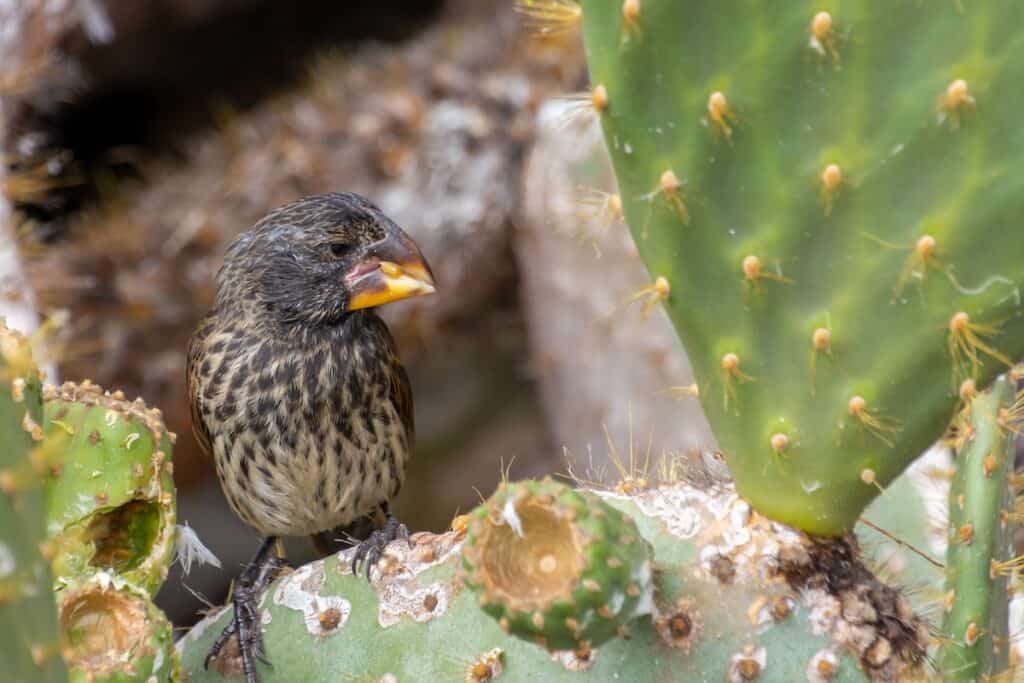
The cactus finch enjoys a bloom in the Galápagos—a tiny but iconic part of Darwin’s remarkable wildlife discoveries.
Galápagos Finches
Galápagos finches (commonly known as Darwin’s finches) include at least 17 closely related species, all of which are endemic to the Galápagos except for one that is found on the remote island of Cocos to the north. Darwin took a special interest in these small birds because they demonstrate a process called adaptive radiation, in which a single ancestral species can evolve into multiple varieties depending on the environments it inhabits.
Beak Adaptations and Diet
The most striking feature of Darwin’s finches is their highly diverse beak shapes, which have evolved to match specific diets and feeding strategies needed to occupy different environmental niches. These adaptations are critical for survival, as the islands’ food resources can vary dramatically by habitat and season.
- Large Ground Finch (Geospiza magnirostris): Deep, strong, broad beaks ideal for cracking large, tough seeds.
- Small Ground Finch (Geospiza fuliginosa): Narrower beaks suited to smaller seeds.
- Cactus Finches (Geospiza scandens, G. conirostris): Long, pointed beaks for feeding on cactus flowers, nectar, and pulp while avoiding spines.
- Warbler Finch (Certhidea olivacea): Thin, pointed beaks specialized for insect feeding.
- Woodpecker or “Tool Using” Finch (Camarhynchus pallidus): Uses tools like twigs or cactus spines to extract insects from bark.
- Mangrove Finch (Camarhynchus heliobates): Robust beaks adapted for insects, small seeds, and mangrove fruits in mangrove habitats.
- Vampire Ground Finch (Geospiza septentrionalis) is endemic to the northern islands of Wolf and Darwin, and is most famous for its unusual diet. When food is scarce, it will occasionally feed by drinking the blood of other birds, most notably the Nazca Booby.
Darwin’s finches inhabit a wide range of environments across the archipelago, including arid lowlands, highland forests, dunes, and mangroves. They typically nest in shrubs and small trees, and their feeding strategies reflect the specific food sources available in their habitats.
Quick Facts:
- Average Lifespan: 15–20 years; highly variable by species
- Average Size: 4–8 inches long by body; weighing 0.2 to 1.5 ounces.
- Habitat & Range: Arid lowlands, highland forests, dunes, mangroves
- Diet: Varies by species—includes seeds, buds, flowers, nectar, insects, and occasionally blood.
- Conservation Status: Most species are Least Concern; Mangrove Finch and Medium Tree Finch are Critically Endangered
- Where to See Them: Forested highlands of Santa Cruz and Floreana for various tree and ground finches; mangrove habitats on Isabela for the rare Mangrove Finch
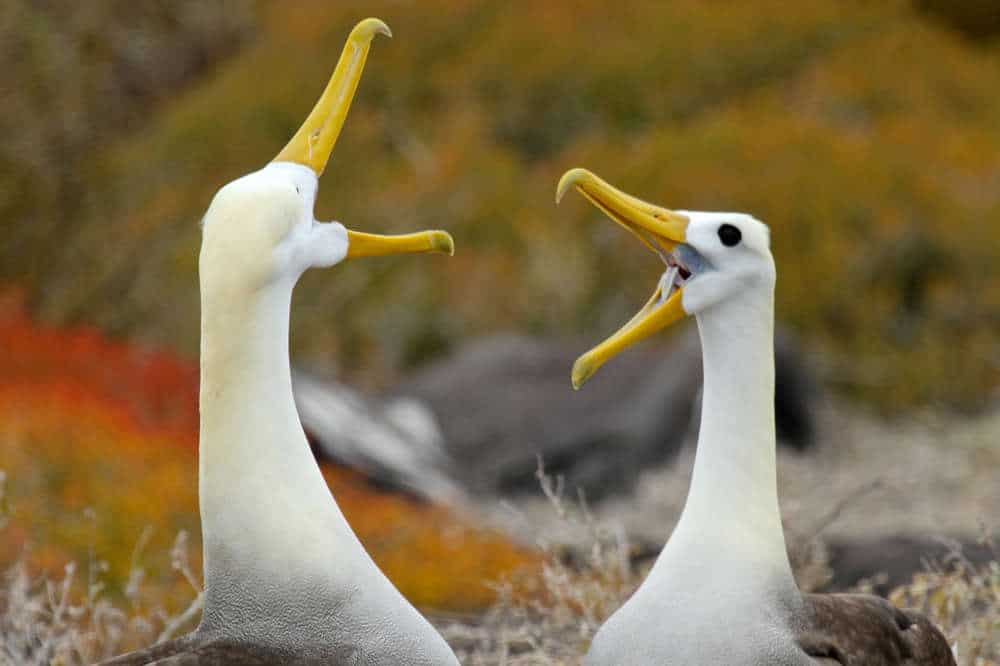
Up close interaction: Waved Albatrosses engage beak-to-beak in a fascinating display of communication. © Wayne Sentman
Waved Albatross (Phoebastria irrorata)
The Waved Albatross is another Galápagos endemic, and Española (Hood) Island is home to the species entire global nesting population. It is the largest bird in the archipelago, with a wingspan of up to 8 feet. Both males and females have white heads with creamy yellow crowns and necks, while their bodies are mainly chestnut brown with white breasts and underwings. They are named for the wave-like pattern on the adults’ wings and, like all albatrosses, are exceptional gliders, spending most of their lives soaring above the open ocean.
One of their most fascinating behaviors is the courtship dance that can be seen adjacent to the tourist path during their breeding season (April-June); it includes bill circling, clacking, head nodding, waddling, and a cow-like “moo” and is a ritual that is particularly elaborate for new pairs. Waved Albatrosses mate for life, and the female lays a single egg on bare ground, which the pair then takes turns incubating for up to two months until hatching.
Quick Facts:
- Average Lifespan: 30 years
- Average Size: 7 to 8 foot wingspan, 2–3 feet long by body, weighing 6-9 lbs
- Habitat & Range: The Waved Albatross breeds exclusively on Española (Hood) Island, nesting on flat, lava-strewn areas
- Diet: Squid, fish, and crustaceans. They are also known to steal regurgitated food from other birds.
- Conservation Status: Critically Endangered. The species faces significant threats from human activities, including long-line fishing, marine pollution, and illegal harvesting for food and feathers, which has increased in recent years.
- Where to See Them: Waved Albatrosses breed exclusively on Española Island, where they can be observed from April to December during nesting and chick rearing. From January to March, they are at sea, with young birds remaining offshore for up to six years before returning to breed.
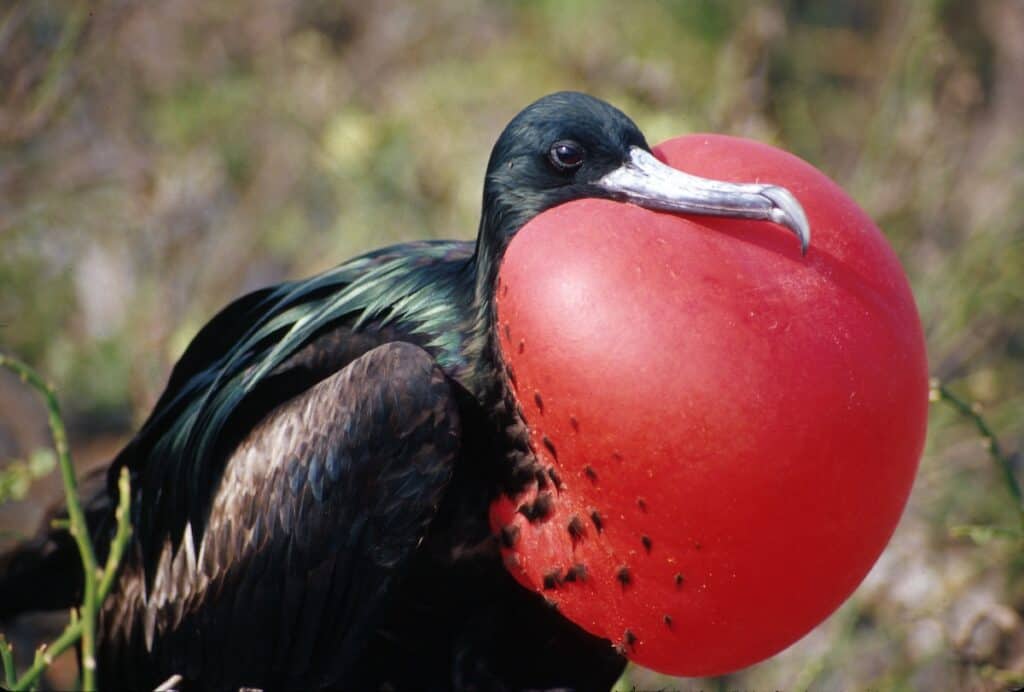
A male Great Frigatebird flaunts its vibrant red throat pouch. © Roderic Mast
Magnificent Frigatebird (Fregata magnificens)
The Magnificent Frigatebird, one of two frigates found in the archipelago (the other being the Great Frigate, Fregata minor), is a striking seabird with a wingspan of up to eight feet, making it one of the largest in the Galápagos. Males are best known for their bright red throat pouch, which they inflate like a balloon and drum on with their bills to attract females.
Unlike most seabirds, frigatebirds rarely land on the water. Instead, they skim the ocean’s surface to snatch shallow-swimming fish. They are also notorious for harassing other seabirds until they regurgitate their catch, which the frigatebird then steals, a behavior known as kleptoparasitism.
Although Magnificent Frigatebirds are found across the Caribbean and Pacific coasts, and can fly hundreds of miles across the open ocean, the colony on the Galápagos is a distinct population that genetically diverged hundreds of thousands of years ago.
Quick Facts:
- Average Lifespan: 25–35 years
- Average Size: 7 to 8 foot wingspan, 35–45 inches long, weighing 2-4 lbs.
- Habitat & Range: Coastal mangroves and treelines throughout the archipelago
- Diet: Carnivorous — Small fish, often taken from the surface or stolen from other birds
- Conservation Status: Least Concern. An estimated 2,000 individuals live on the Galapagos, and are considered a stable population.
- Where to See Them: Breeding colonies on North Seymour, Genovesa, and Española islands.

Snack time in the Galápagos: Flightless Cormorant catches its prey and displays meal dangling from its beak. © Harry Skeggs
Flightless Cormorants (Phalacrocorax harrisi)
The Flightless Cormorant is one of the rarest seabirds in the world—and the only cormorant that cannot fly. With short, stunted wings and powerful legs, these birds have traded flight for exceptional swimming ability, using their webbed feet to pursue fish, eels, and octopuses underwater.
They are found only in the Galápagos, restricted to the western islands of Fernandina and Isabela. There, pairs can be seen nesting on rocky shores, using seaweed and driftwood to build their nests just above the tide line. The species’ isolation and small range make it highly vulnerable, with only about 2,000 individuals remaining.
Quick Facts:
- Average Lifespan: 10–15 years.
- Average Size: 35–39 inches long, 39-inch wingspan, weighing 5–8 lbs.
- Habitat & Range: Rocky shorelines of Fernandina and Isabela islands.
- Diet: Carnivorous — Mainly small fish, eels, octopuses, and other marine animals.
- Conservation Status: Vulnerable; Population threatened by bycatch, warming waters (decreasing food supply), and plastic pollution.
- Where to See Them: Rocky beaches and coves along the coast of Fernandina and Isabela islands.
Sharks of the Galápagos
The Galápagos Islands are one of the best places in the world to encounter sharks. More than 32 different species have been recorded in the surrounding waters, from whale sharks and blacktip reef sharks to hammerheads and the islands’ namesake species—the Galápagos shark. These predators are not only thrilling to observe but also play a crucial role in keeping marine ecosystems healthy.
Galápagos shark (Carcharhinus galapagensis)
The Galápagos shark is a circumtropical species most commonly concentrated in tropical regions of the world’s oceans. It favors warm, clear waters near reef systems, oceanic islands, and continental shelf areas. Although found worldwide, it was first described in 1905 from specimens captured near the Galápagos Islands, from which it takes its name.
Growing up to 10 feet long, the Galápagos shark is the apex marine predator in the coastal waters of the Galápagos. It plays a vital role in maintaining the balance of fish populations and supporting the health of coral reef systems. Despite their global presence, scientists still know relatively little about their life history compared to many other sharks.
Quick Facts:
- Average Lifespan: 20–25 years.
- Average Size: 6.5–10 feet long; weighing 66–180 lbs.
- Habitat & Range: Shallow coastal waters and rocky reefs of tropical oceans
- Diet: Carnivorous — mainly seals, smaller shark species, fish, rays, squid, and crustaceans, and seabirds. Known to be cannibalistic, so young shark pups stay away from groups of adults.
- Conservation Status: Near Threatened. Population size is unknown, but the species is at risk due to bycatch, poaching for fins, and harvesting of teeth and bones for traditional medicine and jewelry.
- Where to See Them: Coastal dive sites near Fernandina and western Isabela islands, especially in marine protected zones during eco-tourism snorkeling and diving expeditions
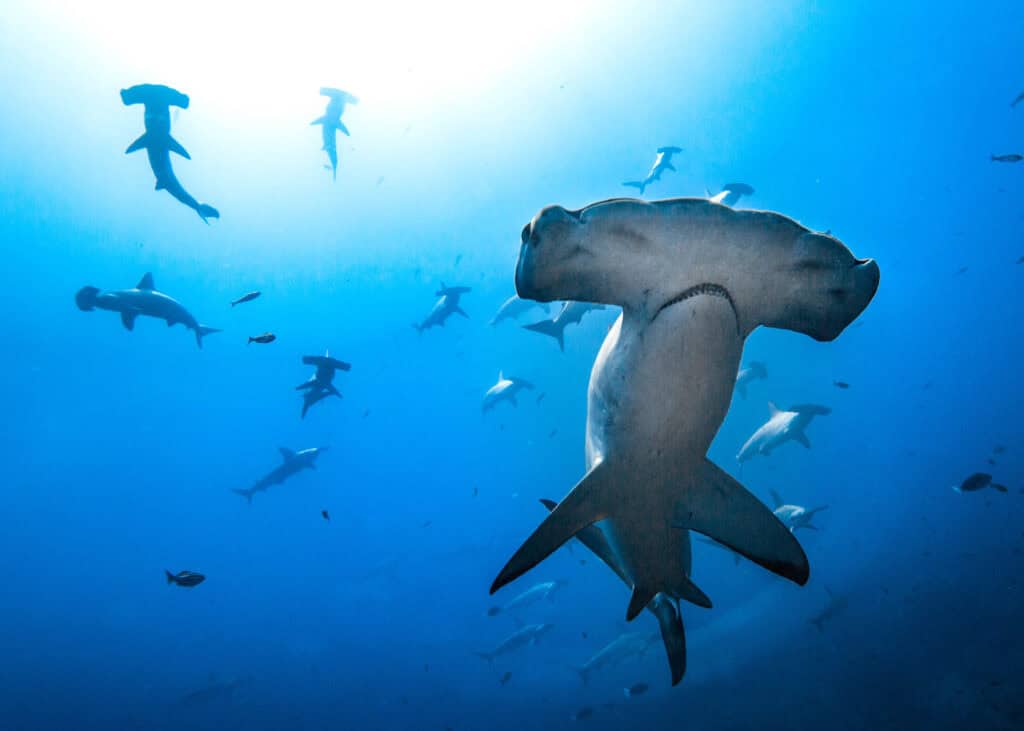
Dive into the Galápagos: A mesmerizing bottom-up view of a school of scalloped hammerhead sharks, a highlight of specialized dive trips. © Masayuki Agawa / Ocean Image Bank
Scalloped Hammerheads (Sphyrna lewini)
The scalloped hammerhead is among the most iconic predators in the world, with its distinctive flattened head, or “cephalofoil”. This unique adaptation enhances their ability to detect faint electrical signals from prey, such as squid and mackerel. In the Galápagos, divers can witness one of the ocean’s great spectacles: massive schools of scalloped hammerheads, often numbering in the hundreds, drifting gracefully in circular formations. These encounters are a highlight of diving in the Galápagos Marine Reserve.
Quick Facts:
- Average Lifespan: 20–30 years.
- Average Size: 8–12 feet long, weighing 100–250 lbs.
- Habitat & Range: Coastal waters, especially near rocky reefs and seamounts.
- Diet: Carnivorous – fish, squid, rays, and smaller sharks.
- Conservation Status: Critically Endangered. Unknown population number. Threatened by bycatch and poaching for their fins (used in shark fin soup).
- Where to See Them: The highest chance of encountering scalloped hammerheads is on specialized dive trips to Wolf and Darwin Islands, and even then, sightings are never guaranteed. Since scalloped hammerheads typically inhabit deeper waters, snorkeling is not a viable option.
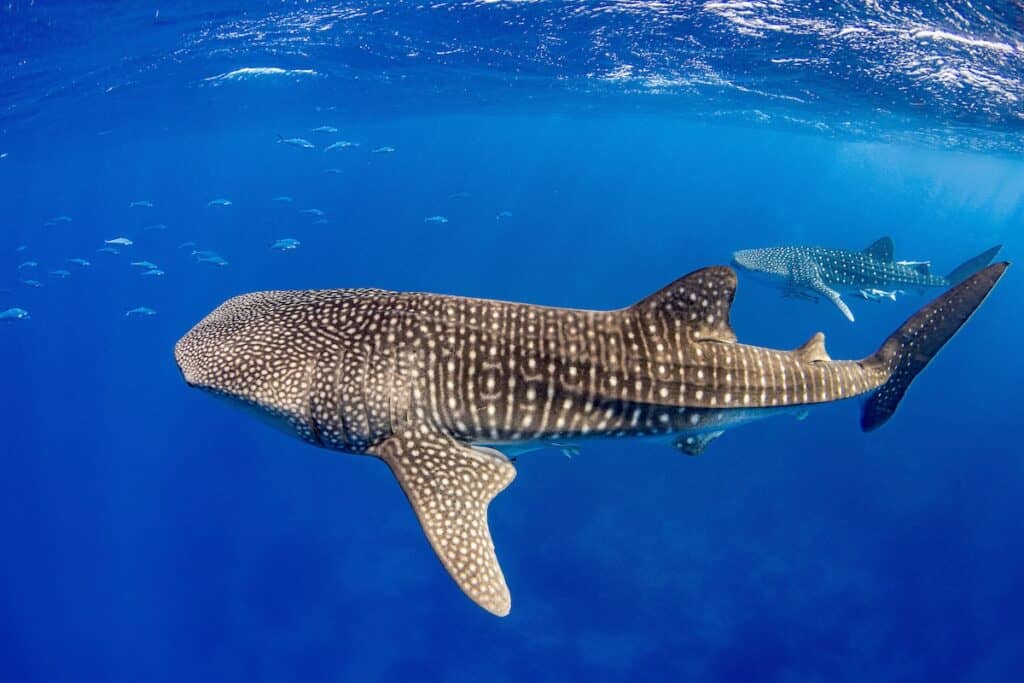
Rare encounter: Two whale sharks glide through the Galápagos, a sight reserved for specialized scuba-only trips to Darwin and Wolf Islands. © Renata Romeo / Ocean Image Bank
Whale Sharks (Rhincodon typus)
The whale shark is the largest fish species in the world and an occasional visitor to the Galápagos between June and November. Despite their massive size, whale sharks are gentle, filter-feeders, gliding through the water with mouths wide open, straining plankton, krill, and small schooling fish from the sea. They are typically solitary, feeding alone in tropical waters and diving as deep as 6,000 feet. In the Galápagos, whale sharks are rare to spot and are only seen on specialized, scuba-only trips to Darwin and Wolf Islands, but when conditions align, they do appear, offering a truly spectacular encounter.
Quick Facts:
- Average Lifespan: 70–100 years.
- Average Size: 30–40 feet long, weighing 15–20 tons.
- Habitat & Range: Open coastal waters surrounding the archipelago.
- Diet: Filter-feeder—plankton, krill, small fish, and fish eggs
- Conservation Status: Endangered. Up to 200,000 whale sharks are estimated to remain in the world’s oceans. Threatened by habitat loss, vessel strikes, unsustainable tourism, and bycatch.
- Where to See Them: Whale sharks are rare, deep-water animals that appear in the Galápagos between June and November, primarily around Darwin and Wolf Islands in the far north of the archipelago. During these months, the best chance to see them is on a specialized scuba diving trip to Darwin and Wolf, though sightings are never guaranteed.
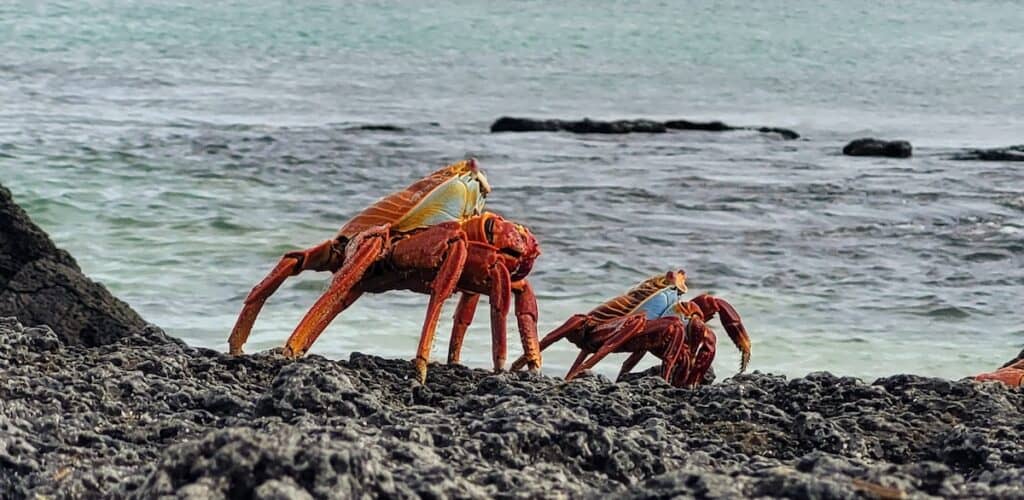
he vivid sally lightfoot crab scuttles across the rocky shores of the Galápagos, a flash of color against the volcanic coastline. © Cecibel Guerrero
Sally Lightfoot Crab (Grapsus grapsus)
The sally lightfoot crab is one of the most ubiquitous and colorful species found on the Galápagos Islands, patterned in vibrant hues of red, orange, and turquoise. Present on virtually every rocky shore, these crabs can often be seen in large numbers, making for a wonderful picture for wildlife photographers.
Ecologically, sally lightfoot crabs play the role of scavenger, and they maintain the health of shoreline ecosystems by cleaning up organic material and helping prevent algae overgrowth. They also serve as a food source for a variety of Galápagos predators, including various birds and reptiles.
- Average Lifespan: 5–10 years.
- Average Size: Up to 5 inches wide.
- Habitat & Range: Rocky shorelines and tidepools throughout the Galápagos Islands
- Diet: Omnivorous — primarily algae, but also carrion, bird droppings, and other organic matter
- Conservation Status (IUCN): Least Concern.
- Best Place to See Them: Black lava rocks along shorelines of most islands (high visibility at low tide); commonly observed at visitor sites such as Punta Suárez. (Española), Puerto Ayora docks (Santa Cruz), and Punta Espinosa (Fernandina).
Invasive Species in the Galápagos
The Galápagos Islands are home to one of the most unique and fragile ecosystems on Earth. Shaped by millions of years of isolation, the archipelago’s wildlife evolved without many of the predators and competitors found elsewhere. But this very isolation also makes the islands especially vulnerable to invasive species—organisms introduced by humans, intentionally or accidentally, into places where they are not native.
Once introduced, invasive species often spread rapidly because they arrive without natural predators. This gives them an advantage over native species, disrupting the delicate ecological balance that makes the Galápagos so extraordinary.
Black Rats and Feral Cats
Rats and feral cats are among the most damaging invasive animals in the Galápagos. Both prey heavily on the eggs, hatchlings, and even adults of reptiles and seabirds. Ground-nesting species are particularly vulnerable, including storm petrels, lava lizards, and marine iguanas.
The Avian Vampire Fly (Philornis downsi)
Among the most insidious invasive species is the avian vampire fly, a parasitic insect accidentally introduced to the Galápagos. The fly lays its eggs in bird nests, and once the larvae hatch, they feed on the blood and tissues of hatchlings.
This parasitism has severely reduced the survival of several iconic bird species, including Darwin’s finches.
Other Invasive Species and Their Impacts
While mammals and insects draw the most attention, other invasive species have also left their mark:
- Goats, pigs, and donkeys overgraze native plants, destroy tortoise habitat, and cause soil erosion.
- Invasive plants such as the Hill raspberry outcompete native vegetation, altering food sources for giant tortoises and birds.
- Invertebrates like fire ants threaten hatchlings of reptiles and ground-nesting birds.
- Frogs, particularly the Fowler’s snouted treefrog (Scinax quinquefasciatus), an invasive species introduced in the late 1990s. This frog became established in wetlands, posing risks to the native ecosystem by competing with native insect-eaters and potentially affecting other species through parasites or by altering the food web.
Conservation and Eradication Efforts
To combat these threats, conservation organizations have launched eradication and control programs. Goats have been removed from several islands through coordinated campaigns, and rodent eradication projects are ongoing. Travelers play a critical role by following all guidelines set by the Galápagos National Park, such as cleaning shoes and gear before island visits, not bringing food or seeds, and staying on marked trails and respecting biosecurity checkpoints.

A scenic view of Kicker Rock in the Galápagos, rising dramatically from the ocean under a clear sky, with calm waters in the foreground. © Ecoventura
Protecting the Wildlife of the Galápagos Islands
The Galápagos Islands are home to wildlife found nowhere else on Earth. Having evolved in isolation, the archipelago’s species are equally unique as they are vulnerable. Human activity, climate change, and invasive species all pose serious threats to this fragile ecosystem.
Conservation programs, strict environmental regulations, and the creation of the Galápagos Marine Reserve have helped protect many of these iconic species, but they need continued support. Sustainable ecotourism can help by supporting frontline conservationists and researchers who are dedicated to conserving this unique natural wonder.
The Galápagos Marine Reserve
The Galápagos Marine Reserve is a vast expanse of over 51,000 square miles of marine protected habitat, encompassing all the coastal waters of the archipelago. The strict protections for marine life are a primary reason its marine habitat is bustling with life.
Much of the reserve is designated as a “no-take zone”, which outlaws fishing. Ocean-based tourism (snorkeling, diving, etc.) is also highly regulated; all activities must be conducted through licensed operators who follow specific environmental protocols to ensure wildlife is not disturbed.
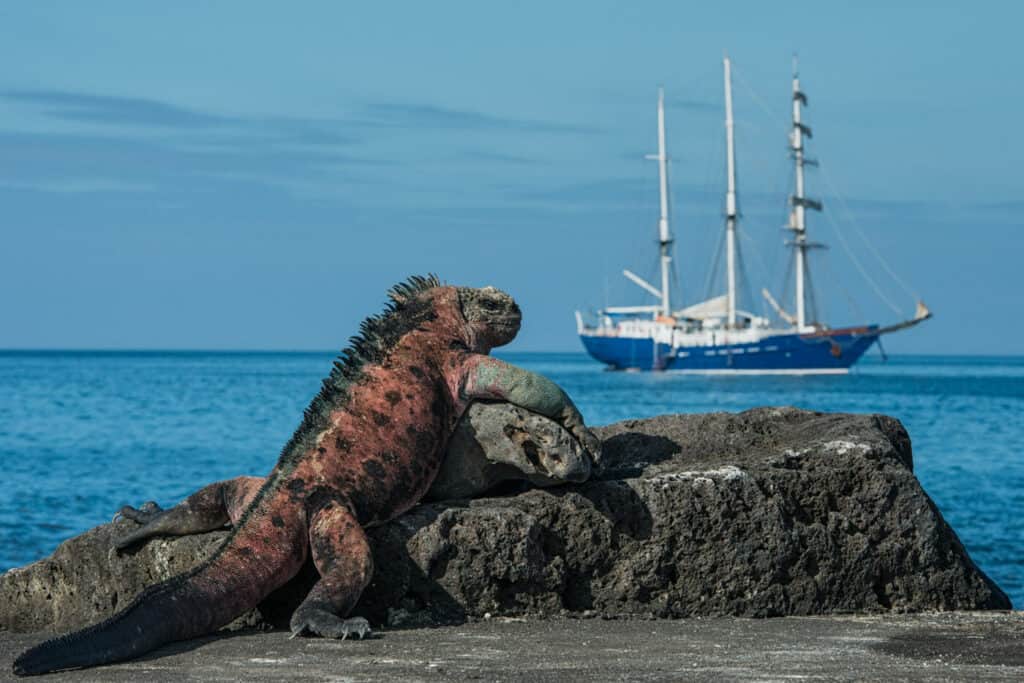
Perched above the Galápagos waters, this marine iguana watches as an Oceanic Society liveaboard cruise glides by—a front-row seat to an unforgettable eco-adventure. © Pete Oxford
Eco Tours to the Galápagos Islands
As a nonprofit organization, the Oceanic Society is committed to both exploration and conservation. Our expeditions are designed to immerse travelers in the islands’ most vibrant ecosystems, from snorkeling in crystal-clear waters to hiking across volcanic landscapes, all while directly supporting vital conservation projects. Every trip helps fund research, protect wildlife, and sustain the unique habitats of the Galápagos.
👉 Inquire about Galápagos expedition dates aboard boutique ships and sign up for our newsletter to receive expedition updates, travel inspiration, and ocean conservation insights delivered straight to your inbox.

